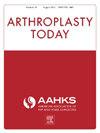原发性全髋关节置换术的手术方法不应受腹腔肿块影响
IF 1.5
Q3 ORTHOPEDICS
引用次数: 0
摘要
背景肿块增大是前路全髋关节置换术(THA)并发症的一个风险因素。然而,目前还不清楚改用后路是否能减轻这种风险。本研究旨在评估腹部包膜大小对前路与后路全髋关节置换术并发症发生率的影响是否存在差异。方法 对一千名连续的初次 THA 患者(478 名前路患者和 522 名后路患者)进行了并发症回顾性检查,并在骨盆前正位图像上对他们的腹部包块进行了影像学测量,根据其垂直尺寸将其分为 4 个类别(无包块 [G0]、干骺端以上 [G1]、干骺端以下 [G2] 或峡部结节以下 [G3])。单变量和逻辑回归模型的卡方检验对年龄、种族、性别、体重指数、Charlson 合并症指数和吸烟进行了控制。9% vs 3.9%,P = .21;G1 7.2% vs 6.7%,P = .08;G2 17.9% vs 11.6%,P = .27;G3 16.7% vs 15.5%,P = .84),再次手术的结果相似(G0 0.9% vs 1.1%,P = .080;G1 1.4% vs 2%,P = .72;G2 3.0% vs 5.8%,P = .41;G3 1.7% vs 4.5%,P = .33)。此外,Logistic 回归模型显示,在每种pannus大小的方法中,伤口并发症或再次手术的几率没有统计学意义上的显著差异。结论在腹部pannus患者中,前路与后路方法相比,伤口延迟愈合或术后90天内再次手术的风险没有差异。本文章由计算机程序翻译,如有差异,请以英文原文为准。
Abdominal Pannus Should Not Dictate Surgical Approach in Primary Total Hip Arthroplasty
Background
Increased pannus size is a risk factor for complications with anterior approach total hip arthroplasty (THA). However, it is unclear if changing to a posterior approach mitigates this risk. The purpose of this study was to evaluate whether abdominal pannus size had a differential effect on complication rate comparing anterior vs posterior THA.
Methods
One thousand consecutive primary THA patients—478 anterior and 522 posterior—were retrospectively reviewed for complications and their abdominal pannus was radiographically measured on an anteroposterior pelvis image and placed into 1 of 4 categories based on its vertical size (no pannus [G0], above symphysis [G1], below symphysis [G2], or below ischial tuberosities [G3]). Chi-squared tests for univariate and logistic regression models controlled for age, race, gender, body mass index, Charlson comorbidity index, and smoking.
Results
Comparing wound complications at increasing pannus size, anterior vs posterior (G0 1.9% vs 3.9%, P = .21; G1 7.2% vs 6.7%, P = .08; G2 17.9% vs 11.6%, P = .27; G3 16.7% vs 15.5%, P = .84), similar results were found with reoperations (G0 0.9% vs 1.1%, P = .080; G1 1.4% vs 2%, P = .72; G2 3.0% vs 5.8%, P = .41; G3 1.7% vs 4.5%, P = .33). Additionally, logistic regression models demonstrated no statistically significant difference in the odds of wound complications or reoperations between the approaches at each pannus size.
Conclusions
In patients with an abdominal pannus, there is no difference in the risk of delayed wound healing or reoperation within 90 postoperative days comparing anterior to posterior approach.
求助全文
通过发布文献求助,成功后即可免费获取论文全文。
去求助
来源期刊

Arthroplasty Today
Medicine-Surgery
CiteScore
2.90
自引率
0.00%
发文量
258
审稿时长
40 weeks
期刊介绍:
Arthroplasty Today is a companion journal to the Journal of Arthroplasty. The journal Arthroplasty Today brings together the clinical and scientific foundations for joint replacement of the hip and knee in an open-access, online format. Arthroplasty Today solicits manuscripts of the highest quality from all areas of scientific endeavor that relate to joint replacement or the treatment of its complications, including those dealing with patient outcomes, economic and policy issues, prosthetic design, biomechanics, biomaterials, and biologic response to arthroplasty. The journal focuses on case reports. It is the purpose of Arthroplasty Today to present material to practicing orthopaedic surgeons that will keep them abreast of developments in the field, prove useful in the care of patients, and aid in understanding the scientific foundation of this subspecialty area of joint replacement. The international members of the Editorial Board provide a worldwide perspective for the journal''s area of interest. Their participation ensures that each issue of Arthroplasty Today provides the reader with timely, peer-reviewed articles of the highest quality.
 求助内容:
求助内容: 应助结果提醒方式:
应助结果提醒方式:


